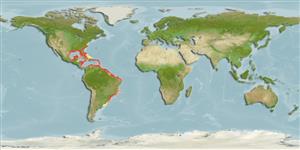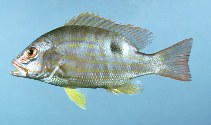Add your observation in Fish Watcher
| Native range | All suitable habitat | Point map | Year 2050 |

|
| This map was computer-generated and has not yet been reviewed. |
| Lutjanus synagris AquaMaps Data sources: GBIF OBIS |
Puerto Rico country information
Common names:
Arrayado, Lane snapper, Manchego
Occurrence: native
Salinity: marine
Abundance: | Ref:
Importance: | Ref:
Aquaculture: | Ref:
Regulations: | Ref:
Uses: no uses
Comments: Also Ref. 50307.
National Checklist:
Country Information: https://www.cia.gov/library/publications/resources/the-world-factbook/geos/rq.html
National Fisheries Authority:
Occurrences: Occurrences Point map
Main Ref: Allen, G.R., 1985
National Database:
Occurrence: native
Salinity: marine
Abundance: | Ref:
Importance: | Ref:
Aquaculture: | Ref:
Regulations: | Ref:
Uses: no uses
Comments: Also Ref. 50307.
National Checklist:
Country Information: https://www.cia.gov/library/publications/resources/the-world-factbook/geos/rq.html
National Fisheries Authority:
Occurrences: Occurrences Point map
Main Ref: Allen, G.R., 1985
National Database:
Common names from other countries
Classification / Names Κοινά ονόματα | Συνώνυμα | Catalog of Fishes(Γένος, Είδη) | ITIS | CoL | WoRMS | Cloffa
> Eupercaria/misc (Various families in series Eupercaria) > Lutjanidae (Snappers) > Lutjaninae
Etymology: Lutjanus: Malay, ikan lutjan, name of a fish.
More on author: Linnaeus.
Etymology: Lutjanus: Malay, ikan lutjan, name of a fish.
More on author: Linnaeus.
Environment: milieu / climate zone / depth range / distribution range Οικολογία
Θαλασσινό(ά) Υφαλόφιλο(α); εύρος βάθους 10 - 400 m (Ref. 9626), usually 21 - 70 m (Ref. 9626). Subtropical; 38°N - 38°S, 98°W - 31°W (Ref. 55253)
Κατανομή Χώρες | Περιοχές FAO | Οικοσυστήματα | Παρουσίες | Point map | Εισαγωγές | Faunafri
Western Atlantic: Bermuda (Anderson, pers. comm.) and North Carolina, USA to southeastern Brazil, including Gulf of Mexico and Caribbean Sea (Ref. 9626). Most abundant around the Antilles, on the Campeche Bank, off Panama and the northern coast of South America. Lutjanus ambiguus (Poey, 1860), an intergeneric hybrid with Ocyurus chrysurus (Bloch) as demonstrated by Loftus (1992: Ref. 33006), followed by McEachran &. Fechhelm (2005: Ref. 78464).
Length at first maturity / Μέγεθος / Βάρος / Age
Maturity: Lm 23.4, range 16 - 21.5 cm
Max length : 60.0 cm TL αρσενικό/απροσδιόριστο; (Ref. 40637); common length : 25.0 cm TL αρσενικό/απροσδιόριστο; (Ref. 55); μεγ. δημοσιευμένο βάρος: 3.5 kg (Ref. 40637); μεγ. αναφερόμενη ηλικία: 10 έτη (Ref. 3090)
Max length : 60.0 cm TL αρσενικό/απροσδιόριστο; (Ref. 40637); common length : 25.0 cm TL αρσενικό/απροσδιόριστο; (Ref. 55); μεγ. δημοσιευμένο βάρος: 3.5 kg (Ref. 40637); μεγ. αναφερόμενη ηλικία: 10 έτη (Ref. 3090)
Short description Κλείδες προσδιορισμού | Μορφολογία | Μορφομετρία
Ραχιαίες άκανθες (συνολικά) : 10; Μαλακές ραχιαίες ακτίνες (συνολικά) : 12 - 13; Εδρικές άκανθες: 3; Μαλακές εδρικές ακτίνες: 8 - 9. Preopercular notch and knob weak. Pectoral fins short, not reaching level of anus. Scale rows on back rising obliquely above lateral line. Back and upper side pink to reddish, with a green tinge and diffused darker vertical bars. The lower sides and belly silvery with a yellow tinge. A series of 8 - 10 horizontal yellow or golden stripes on sides. A diffused black spot mainly above the lateral line and below the anterior portion of the soft dorsal-fin rays.
Adults are found over all types of bottom, but mainly around coral reefs and on vegetated sandy areas. In turbid as well as clear water (Ref. 9710). They often form large aggregations, especially during the breeding season. Feed at night on small fishes, bottom-living crabs, shrimps, worms, gastropods and cephalopods. Good food fish, it is marketed fresh.
Life cycle and mating behavior Γεννητική Ωρίμανση | Αναπαραγωγή | Γεννοβολία | Αβγά | Γονιμότητα | Προνύμφες
Often form large aggregations, especially during the breeding season.
Main reference
Upload your references | Αναφορές | Συντονιστής | Συνεργάτες
Allen, G.R., 1985. FAO Species Catalogue. Vol. 6. Snappers of the world. An annotated and illustrated catalogue of lutjanid species known to date. FAO Fish. Synop. 125(6):208 p. Rome: FAO. (Ref. 55)
IUCN Red List Status (Ref. 130435: Version 2024-2)
Near Threatened (NT) ; Date assessed: 10 October 2015
Human uses
αλιεία: Εμπορικό(ά); αλιεία αναψυχής: ναί; Ενυδρείο: Δημόσια ενυδρεία
FAO(αλιεία: Παραγωγή; publication : search) | FishSource | Η θάλασσα γύρω μας
Περισσότερες πληροφορίες
Population dynamics
Παράμετροι Αύξησης
Max. ages / sizes
Length-weight rel.
Length-length rel.
Length-frequencies
Mass conversion
Στρατολόγηση
Αφθονία
Παράμετροι Αύξησης
Max. ages / sizes
Length-weight rel.
Length-length rel.
Length-frequencies
Mass conversion
Στρατολόγηση
Αφθονία
Life cycle
Αναπαραγωγή
Γεννητική Ωρίμανση
Γονιμότητα
Γεννοβολία
Spawning aggregations
Αβγά
Egg development
Προνύμφες
Δυναμική προνυμφών
Αναπαραγωγή
Γεννητική Ωρίμανση
Γονιμότητα
Γεννοβολία
Spawning aggregations
Αβγά
Egg development
Προνύμφες
Δυναμική προνυμφών
Anatomy
Επιφάνεια βραγχίων
Brain
Otolith
Επιφάνεια βραγχίων
Brain
Otolith
Physiology
Body composition
Nutrients
Κατανάλωση οξυγόνου
Κολυμβητικός τύπος
Ταχύτητα κολύμβησης
Visual pigments
Fish sound
Diseases & Parasites
Toxicity (LC50s)
Body composition
Nutrients
Κατανάλωση οξυγόνου
Κολυμβητικός τύπος
Ταχύτητα κολύμβησης
Visual pigments
Fish sound
Diseases & Parasites
Toxicity (LC50s)
Genetics
Γενετική
Heterozygosity
Κληρονομικότητα
Γενετική
Heterozygosity
Κληρονομικότητα
Human related
Aquaculture systems
Προφίλ υδατοκαλλιεργειών
Στελέχοι
Ciguatera cases
Stamps, coins, misc.
Aquaculture systems
Προφίλ υδατοκαλλιεργειών
Στελέχοι
Ciguatera cases
Stamps, coins, misc.
Εργαλεία
E-book | Οδηγός πεδίου | Κλείδες προσδιορισμού | Ανάλυση κατά μήκος συνθέσεων | Εργαλείο ιστορίας ζωής | Σημειακός χάρτης | Classification Tree
| Catch-MSY |
Special reports
Download XML
Διαδικτυακές πηγές
Aquatic Commons | BHL | Cloffa | Websites from users | Check FishWatcher | CISTI | Catalog of Fishes(Γένος, Είδη) | DiscoverLife | ECOTOX | Faunafri | Fishtrace | GenBank(genome, nucleotide) | GloBI | GOBASE | GoMexSI (interaction data) | | Google Books | Google Scholar | Google | IGFA World Record | MitoFish | Εθνικές βάσεις δεδομένων | Otolith Atlas of Taiwan Fishes | Δημόσια ενυδρεία | PubMed | Reef Life Survey | RFE Identification | Scirus | SeaLifeBase | Δέντρο Ζωής | Wikipedia(Go, αναζήτηση) | World Records Freshwater Fishing | Zoological Record
Estimates based on models
Preferred temperature (Ref. 115969): 19.7 - 27.5, mean 24.7 (based on 260 cells).
Phylogenetic diversity index (Ref. 82804): PD50 = 0.5000 [Uniqueness, from 0.5 = low to 2.0 = high].
Bayesian length-weight: a=0.01514 (0.01359 - 0.01685), b=2.96 (2.94 - 2.98), in cm Total Length, based on LWR estimates for this species (Ref. 93245).
Τροφικό Επίπεδο (Ref. 69278): 3.8 ±0.2 se; based on diet studies.
Ελαστικότητα (Ref. 120179): Μεσαίο(α), ελάχιστος χρόνος για διπλασιασμό πληθυσμού 1,4 - 4,4 έτη (K=0.13-0.26; tm=2; tmax=10).
Prior r = 0.87, 95% CL = 0.57 - 1.30, Based on 6 data-limited stock assessments.
Fishing Vulnerability (Ref. 59153): Moderate vulnerability (37 of 100).
Climate Vulnerability (Ref. 125649): High to very high vulnerability (74 of 100).





